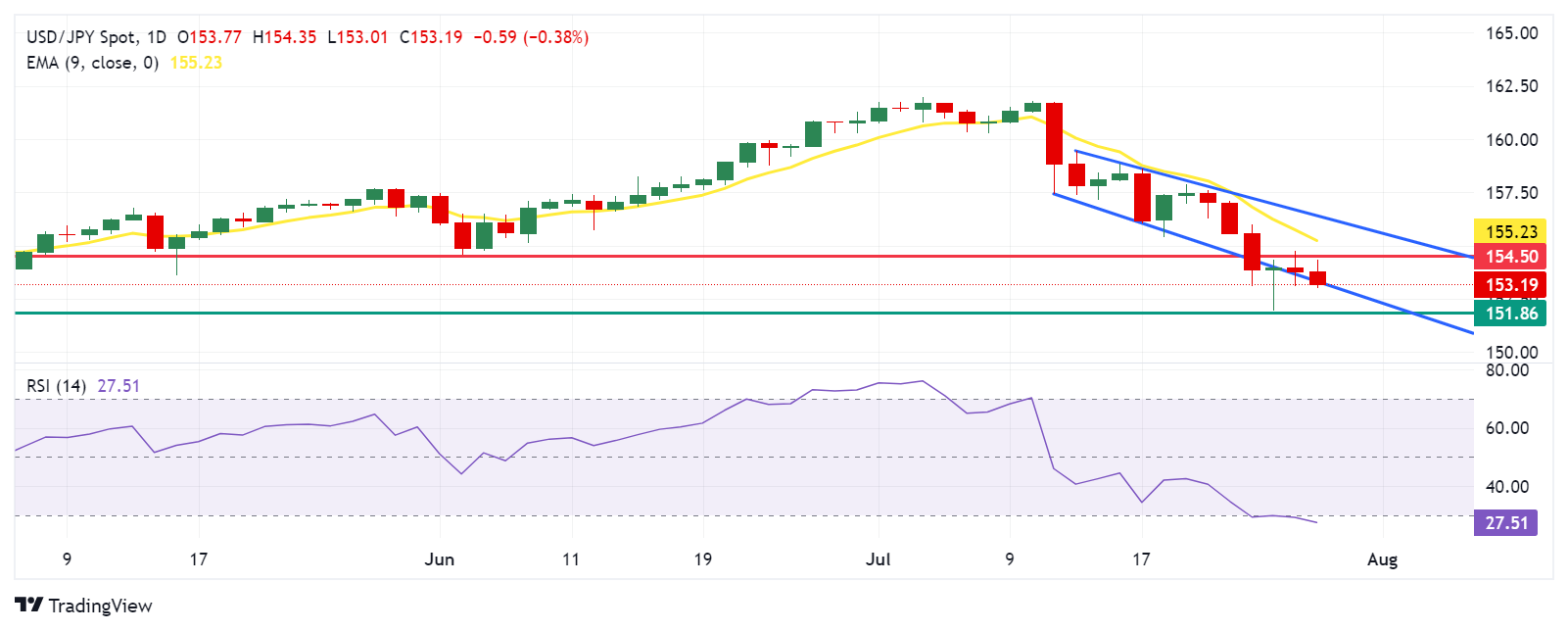- Japanese yen appreciates as BoJ could raise rates by 10 basis points on Wednesday.
- The Bank of Japan is widely expected to announce plans to reduce bond purchases.
- The US dollar is weakening as signs of cooling inflation have fueled the likelihood of three rate cuts by the Fed in 2024.
The Japanese Yen (JPY) continues to gain ground on Monday as traders remain cautious ahead of the Bank of Japan (BoJ) monetary policy meeting on Wednesday, which could see a possible rate hike. Markets are betting that the BoJ could raise rates by 10 basis points to 0.1% and is widely expected to announce its bond-buying tapering plans.
The JPY could also receive support as traders potentially unwind their carry trades ahead of the Bank of Japan’s policy decision. Japan’s top foreign exchange diplomat Masato Kanda informed the G20 on Friday that foreign exchange (FX) volatility negatively impacts the Japanese economy. Kanda noted an increasing likelihood of a soft landing and stressed the need to monitor the economy and implement necessary measures closely, according to Reuters.
The US Dollar (USD) is facing challenges as cooling inflation and weakening labor market conditions in the United States (US) have fueled expectations of three rate cuts this year by the Federal Reserve (Fed), starting in September.
Daily Market Wrap: Japanese Yen Gains on BoJ Rate Hike Expectations
- Reuters has published a lengthy article on the Bank of Japan’s (BoJ) past policy review, highlighting a significant shift in the central bank’s approach to inflation. The key message of the review is that Japan is “ready for higher rates.” However, the review will not result in changes to the price target or policy framework.
- On Friday, the US Personal Consumption Price Index (PCE) rose 2.5% year-on-year in June, slightly below the 2.6% rise in May, meeting market expectations. On a monthly basis, the PCE Price Index rose 0.1% after being unchanged in May.
- U.S. core PCE inflation, which excludes volatile food and energy prices, also rose to 2.6% in June, consistent with the increase in May and above the 2.5% forecast. The core PCE Price Index rose 0.2% monthly in June, compared with 0.1% in May.
- Tokyo’s overall CPI for July rose 2.2% year-on-year, slightly lower than the previous increase of 2.3%. Tokyo’s CPI excluding fresh food and energy rose 1.5% year-on-year, compared with the previous increase of 1.8%. In addition, the CPI excluding fresh food also rose 2.2% in July, meeting market expectations.
- Bank of America says strong economic growth in the United States allows the Federal Open Market Committee (FOMC) to “afford to wait” before making any changes. The bank says the economy “remains on solid footing” and continues to expect the Fed to begin cutting rates in December.
- Last week, Japan’s Finance Minister Shunichi Suzuki, Chief Cabinet Secretary Yoshimasa Hayashi and top foreign exchange diplomat Masato Kanda all avoided commenting on currency exchange matters, according to Reuters.
- BlackRock Investment Institute noted in its mid-year outlook that the Bank of Japan will not raise interest rates at next week’s meeting. In addition, JP Morgan also anticipated that there will be no rate hike by the Bank of Japan (BoJ) in July or at any time in 2024.
Technical Analysis: USD/JPY drops towards 153.00
USD/JPY is trading around 153.20 on Monday. The daily chart analysis shows that the USD/JPY pair is testing the descending channel, indicating a possible strengthening of the bearish bias. Moreover, the 14-day Relative Strength Index (RSI) is below the 30 level, signaling an oversold situation and suggesting a possible short-term bounce.
A break below the lower boundary of the descending channel around the 153.00 level could exert downward pressure, potentially pushing the USD/JPY pair to revisit the May low of 151.86. Additional support can be found at the psychological level of 151.00.
On the upside, the USD/JPY pair could test the “resistance turned retracement support” around 154.50. Further resistance is likely at the nine-day exponential moving average (EMA) of 155.24, followed by the upper boundary of the descending channel near 156.20.
USD/JPY: Daily Chart
Japanese Yen PRICE Today
The table below shows the Japanese Yen (JPY) exchange rate against major currencies today. The Japanese Yen was the strongest currency against the US Dollar.
| USD | EUR | GBP | JPY | CAD | AUD | NZD | CHF | |
|---|---|---|---|---|---|---|---|---|
| USD | -0.09% | -0.13% | -0.31% | -0.08% | -0.18% | -0.10% | -0.16% | |
| EUR | 0.09% | -0.07% | -0.23% | 0.03% | -0.04% | -0.02% | -0.05% | |
| GBP | 0.13% | 0.07% | -0.20% | 0.09% | 0.03% | 0.07% | 0.03% | |
| JPY | 0.31% | 0.23% | 0.20% | 0.20% | 0.16% | 0.21% | 0.18% | |
| CAD | 0.08% | -0.03% | -0.09% | -0.20% | -0.07% | -0.05% | -0.06% | |
| AUD | 0.18% | 0.04% | -0.03% | -0.16% | 0.07% | 0.05% | -0.02% | |
| NZD | 0.10% | 0.02% | -0.07% | -0.21% | 0.05% | -0.05% | -0.04% | |
| CHF | 0.16% | 0.05% | -0.03% | -0.18% | 0.06% | 0.02% | 0.04% |
The heatmap shows percentage changes of major currencies. The base currency is selected from the left column, while the quote currency is selected from the top row. For example, if you choose the Japanese Yen from the left column and move along the horizontal line to the US Dollar, the percentage change shown in the chart will represent the JPY (base)/USD (quote).
Japanese Yen FAQs
The Japanese Yen (JPY) is one of the most traded currencies in the world. Its value is determined broadly by the performance of the Japanese economy, but more specifically by the policy of the Bank of Japan, the spread between Japanese and US bond yields, and risk sentiment among traders, among other factors.
One of the Bank of Japan’s mandates is currency control, so its moves are key to the Yen. The BoJ has intervened directly in currency markets on occasion, usually to lower the value of the Yen, although it often refrains from doing so due to political concerns of its major trading partners. The BoJ’s current ultra-loose monetary policy, based on massive stimulus to the economy, has caused the Yen to depreciate against its major currency peers. This process has been exacerbated more recently by a growing policy divergence between the BoJ and other major central banks, which have opted to sharply raise interest rates to combat decades-old levels of inflation.
The Bank of Japan’s stance of maintaining an ultra-loose monetary policy has led to an increase in policy divergence with other central banks, in particular with the US Federal Reserve. This favours the widening of the spread between US and Japanese 10-year bonds, which favours the Dollar against the Yen.
The Japanese Yen is often considered a safe haven investment. This means that in times of market stress, investors are more likely to put their money into the Japanese currency due to its perceived reliability and stability. In turbulent times, the Yen is likely to appreciate against other currencies that are considered riskier to invest in.
Source: Fx Street
I am Joshua Winder, a senior-level journalist and editor at World Stock Market. I specialize in covering news related to the stock market and economic trends. With more than 8 years of experience in this field, I have become an expert in financial reporting.








